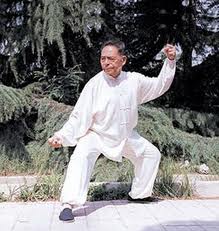Our latest video on internal and external kung-fu ‘Lei Tai’ training
Internal and External Kung-Fu:An essay by Dr. Yingsheng Wu (Wilson)
The famous academician of Qing Dynasty Huang zongxi said in the Epitaph for Wang Zhengnan, “Shaolin style is famous for its attacking techniques, however it could get caught easily. While Internal style always follow and wait for the opportunity to defeat the opponent. So it should be distinguished from Shaolin, and was originated from Zhang Sanfeng of Song Dynasty.” Then his son Huang Baijia said: “External Martial Arts reached its peak times in Shaolin. And Zhang Sanfeng developed Internal Martial Arts after mastering Shaolin.” Ever since then, Internal and External became the 2 main streams of Martial Arts. Xingyi, Bagua, Taiji(Tai Chi) were classified as 3 main Internal styles later on. Here we are not going to discuss whether Internal Martial Arts was originated from Zhang Sanfeng. Instead we are going to identify these two main forms of Martial Arts. Or in other words, why we should distinguish Xingyi, Bagua, Taiji from Shaolin? Some people think that Internal styles focus on the Qi(Chi), while Shaolin styles focus on physical power, or they don’t even practice the internal energy. This is actually not true. The theory of Northern Shaolin says: “strengthen the physique, refine the energy.” The theoary of Southern Shaolin says: “breathe through the body for the power, inhale and exhale for the capacity.” We can see that Shaolin is also emphasizing the breathing and internal energy. Another example is the famous Yi Jin Jing and Xi Sui Jing from Shaolin are all about internal energy training. So Internal and External are referring something more profound and as the result of the co-existing of traditional Chinese culture and foreign cultures.
Why we can draw this conclusion? As we know the core system of Xingyi is the 5 elements form:
Form Meaning
- Pi Splitting
- Zuan Drilling
- Beng Crushing
- Pao Pounding
- Heng Crossing
Element Focus
- Metal Lung
- Water Kidney
- Wood Liver
- Fire Heart
- Earth Spleen
As for Bagua, its foundation is circle walking. The purpose is to center your opponent and move to eight directions: Qian (North), Kun (South), Kan (East), Li (West), Zhen (Southwest), Xun (Northeast), Gen (Southeast), Dui (Northwest). During the walking keep upper-body steady to allow the heart (fire) to go down and Kidney (water) to go up.
Last one is Taiji, which emphasizes on the contradictory unity. In Taiji we should always focus on Firm and Empty, Open and Close, Motion and Static, Ease and Tightness, etc. or what is called Yin Yang. In that way we can achieve balance of the body.
During the practice Xingyi mainly focuses on vertical circle, Bagua focuses on horizontal circle, while Taiji focuses on tridimensional circle. As said by the famous Internal Martial Artist Sun Lutang: “Xingyi is longitude, Bagua is latitude and Taiji is the mixture of the two”, “Xingyi is like iron ball which is stiff inside out, Bagua is like cage ball which is hollow, Taiji is like leather ball which has both and ethereal. These are the characteristics of the three”.
No matter how different these 3 training systems are, they all centralize in Dan Tian (cyclic center) and are directed by the mind. The outcome is the three components of human body in Taoism: essence, energy and spirit. In summary, these three main internal styles are the direct reflection of the traditional Chinese philosophy which is part of the Chinese culture.
On the other hand, Shaolin worships Buddhist monk Da Mo(Bodhidharma), although most of the Shaolin styles are from local Chinese people. The core method of Shaolin, Yi Jin Jing and Xi Sui Jing are originated from the Indian Supreme Yoga. I have practiced Yi Jin Jing for many years and benefited from it in many ways. One of the examples is winning the championship over other students in high school long-distance race by practicing nothing by Yi Jin Jing. However it simply mentions the coordination of breathing and movements, instead of anything related to Dan Tian or meridian. I realized Yi Jin Jing must be from the same origination with Yoga after verifying the different system with a yoga instructor who had been to India multiple times. Indian yoga emphasizes a high degree of unity of body and soul. Its advanced practice still spreads in India and Tibet (Tantric Qigong).
It has similar refining of the meridians as Chinese medicine and Taoism. The now popular various versions of Yi Jin Jing, if they’re talking about Dan Tian and other Taoist theory, should be regarded as the prop of the Taoism. Therefore, the quote that Shaolin if External style actually should mean that it’s not originated from China but from India. World’s three main classic: I Ching, Vedas, Bible, which the first two belong to the Oriental philosophy and have profound impact on Chinese Martial Arts.
Theory of Xingyi, Bagua and Taiji was derived from the I Ching, thus is native Chinese and is regarded as internal styles. The Supreme Yoga in Vedas is a variety of self-cultivation in India since ancient times, in which Buddhism is no exception. Until the master Bodhidharma brought into the Shaolin Temple in Henan, these cultivation methods had finally become the principle and foundation of Shaolin styles – Yi Jin Jing and Xi Sui Jing. Then master Bodhidharma had also become one of Shaolin’s originators. In my opinion, this is where Shaolin equals External actually originated from.
– Dr. Wushilong (Wilson) Wu



